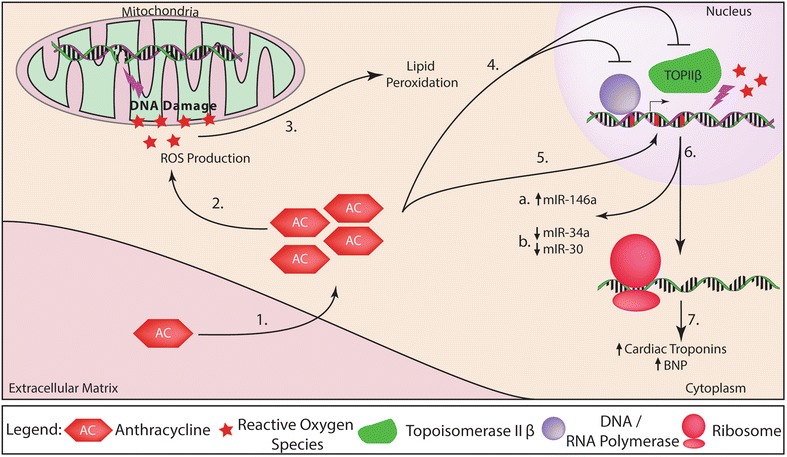Fig. 1.

Actions of anthracyclines within the cell. Anthracyclines (ACs) enter the cell, cause mitochondrial damage, and impair transcription in nuclear DNA. 1 In healthy cells, ACs enter the cell’s cytoplasm and has cytotoxic effects. 2 Products from AC-induced ROS (reactive oxygen species) damage mitochondrial DNA leading to mitochondrial dysfunction. 3 ROS-induced generation of oxidized lipid further damages the host‘s cells. 4 AC also inhibits DNA/RNA synthesis by impairing the initiation or elongation phases during DNA synthesis and blocking transcription factor binding or RNA polymerase activity during RNA synthesis. Additionally, intercalation of AC within the DNA can inhibit Topoisomerase II β (TOP2β) by activating the DNA-damage response that leads to cell death. 5 DNA intercalation further impairs normal DNA/RNA synthesis. 6 ACs can function as transcriptional inhibitors and/or modifiers for translational transcripts: (a) miR-146a is a negative regulator for epithelial growth factor receptor 4 (ErbB4) and is upregulated shortly after AC exposure. (b) Both miR-30 and miR-34a are direct regulators for cell apoptosis and are downregulated shortly after AC treatment in humans and mice. As a result of cardiac injury, troponins and BNP are upregulated due to cardiomyocyte injury and increased circulating levels are detected. Upregulation can result from activation of pro-apoptotic/anti-proliferative pathways that could ultimately lead to cardiac dysfunction if not treated
